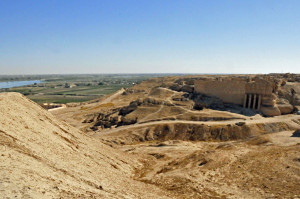Macedonian Greeks built Dura Europos in 303 B.C. atop a steep cliff 300 feet above the west bank of the Euphrates River. Despite its natural protections, the city fell to Persians in 113 B.C. Romans then conquered the city in about 160 A.D., making it a base for their military and commercial operations along the Euphrates. The Roman army and immigrants brought religious beliefs and languages from around the Empire to Dura Europos, making it an early melting pot. In about 256 A.D. Persians again captured the city and deported its residents. Earthen embankments built in an unsuccessful attempt to protect the city collapsed, covering some of the buildings. Sand and mud eventually covered the rest and the city remained hidden for hundreds of years.
Archaeologists began uncovering Dura Europos in 1920 after the British army stumbled onto some ancient paintings. What the archaeologists found was comparable to Pompeii. The sand and mud had stopped time in the third century. Well-preserved wall paintings, now in museums in Syria and the United States, enabled identification of the original purpose of many buildings. A house built in about 235 was used as a church, with a painting of Jesus and Peter walking on water the oldest surviving representation of Jesus. Its baptistery is the oldest one in the world. A large synagogue with 28 colorful paintings of Biblical scenes was dated to about 240, making it the oldest known synagogue outside Israel. Sixteen temples and a Mithraeum honored Greek, Roman, Persian and Canaanite gods.
During the third century, as Christians were being persecuted in Rome, worshippers in the house-church in Dura Europos lived peaceably amid temples to Adonis, Artemis and Ba’al. As anti-Semitism was poisoning relations between Christians and Jews elsewhere, an impressive synagogue was being built near the church. We can all learn about interfaith tolerance and cooperation from ancient ruins near the Euphrates River.

Comments are closed.